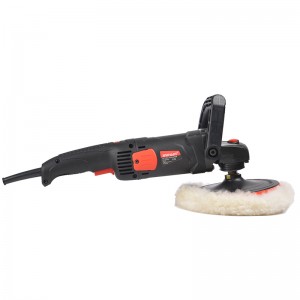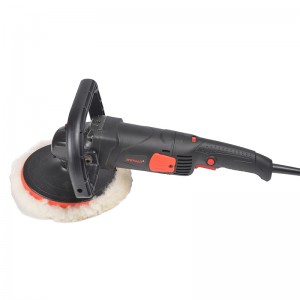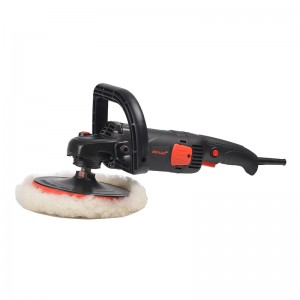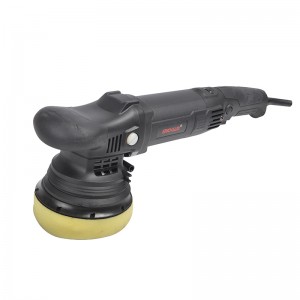In the world of surface finishing and material refinement, the variable speed polisher stands as a versatile and indispensable tool. Whether you are working with metals, wood, stone, or even delicate materials like glass or ceramics, a variable speed polisher offers the precision, control, and adaptability needed to achieve the desired finish. This comprehensive guide delves deep into the realm of variable speed polishers, exploring their mechanisms, applications, benefits, and best practices to help you make the most of this powerful tool.
Understanding Variable Speed Polishers
What Is a Variable Speed Polisher?
A variable speed polisher is a power tool designed to smooth, refine, and enhance the surface of various materials by utilizing a rotating or oscillating pad or disc. Unlike fixed-speed polishers, variable speed models allow users to adjust the speed of the polishing head according to the specific requirements of the task at hand. This flexibility is crucial for achieving optimal results across a wide range of materials and applications.
Key Components of a Variable Speed Polisher
-
Motor: The heart of the polisher, the motor provides the power needed to drive the polishing head. Variable speed polishers typically feature high-torque motors capable of operating at different speeds to accommodate various tasks.
-
Speed Control Mechanism: This component allows users to adjust the speed of the polishing head. It can be a dial, switch, or digital interface that provides precise control over the RPM (revolutions per minute).
-
Polishing Head: The polishing head is the part that comes into direct contact with the material being polished. It can be a flat disc, a buffing wheel, or a pad, depending on the application. The head is usually covered with an abrasive material or a polishing compound.
-
Handle and Ergonomics: A well-designed handle is essential for comfortable and precise operation. Variable speed polishers often feature ergonomic handles that provide a secure grip, reducing user fatigue during extended use.
-
Power Supply: Variable speed polishers can be corded or cordless. Corded models offer continuous power supply but may limit mobility, while cordless models provide greater flexibility but may have limited battery life.
How Variable Speed Polishers Work
The basic principle behind a variable speed polisher is simple yet effective. The motor drives the polishing head, which rotates or oscillates at a user-selected speed. The speed can be adjusted using the control mechanism, allowing the operator to match the speed to the material and the desired finish. The polishing head, coated with an abrasive or polishing compound, is then applied to the surface of the material, removing imperfections and creating a smooth, polished finish.
Applications of Variable Speed Polishers
Metal Polishing
Variable speed polishers are widely used in metalworking industries for tasks such as deburring, surface finishing, and achieving high-gloss finishes. Different metals require different approaches:
-
Stainless Steel: A lower speed is often used to avoid overheating and discoloration. Fine abrasives and polishing compounds are applied to achieve a mirror-like finish.
-
Aluminum: This soft metal requires careful handling to prevent gouging. A medium speed with a soft polishing pad and a suitable compound is ideal for achieving a smooth, polished surface.
-
Copper and Brass: These metals can be polished to a high shine with a variable speed polisher. A combination of coarse and fine abrasives, followed by a polishing compound, is used to remove oxidation and achieve a bright finish.
Wood Polishing
In woodworking, variable speed polishers are essential for smoothing surfaces, removing tool marks, and preparing wood for finishing. The speed can be adjusted based on the type of wood and the desired finish:
-
Hardwoods: Higher speeds can be used for initial sanding and smoothing, while lower speeds are ideal for applying polish or wax to achieve a rich, glossy finish.
-
Softwoods: Care must be taken to avoid burning or damaging the wood. Medium to low speeds are recommended, along with fine abrasives and gentle polishing compounds.
Stone Polishing
Stone surfaces, such as marble, granite, and limestone, require specialized polishing techniques. Variable speed polishers are used to achieve a polished finish that enhances the natural beauty of the stone:
-
Marble: A low to medium speed is used with diamond-embedded pads to remove scratches and achieve a high-gloss finish.
-
Granite: This dense stone requires higher pressure and medium to high speeds. Diamond-impregnated pads and polishing compounds are used to create a smooth, polished surface.
-
Limestone: This porous stone requires gentle handling. Low speeds and fine abrasives are used to avoid damaging the surface.
Plastic and Composite Materials
Variable speed polishers are also used in the plastics and composites industry to remove mold lines, smooth surfaces, and achieve a high-gloss finish. The speed and abrasive used depend on the type of plastic and the desired finish:
-
Acrylics: A low to medium speed with a soft polishing pad and a suitable compound is used to avoid scratching the surface.
-
Polymer Composites: These materials often require a combination of coarse and fine abrasives, followed by a polishing compound, to achieve a smooth, polished finish.

Benefits of Variable Speed Polishers
Precision and Control
One of the primary advantages of variable speed polishers is the level of precision and control they offer. By adjusting the speed of the polishing head, users can match the tool’s performance to the specific requirements of the material and the desired finish. This adaptability is crucial for achieving high-quality results across a wide range of applications.
Versatility
Variable speed polishers are incredibly versatile tools. They can be used on a variety of materials, including metals, wood, stone, plastics, and composites. This versatility makes them an essential tool for workshops, factories, and professionals who work with multiple materials.
Efficiency
The ability to adjust the speed of the polishing head allows users to work more efficiently. For example, a higher speed can be used for initial sanding and smoothing, while a lower speed can be used for fine polishing. This flexibility reduces the time required to achieve the desired finish, making variable speed polishers more efficient than fixed-speed models.
Reduced Risk of Damage
Using a variable speed polisher reduces the risk of damaging the material being polished. By adjusting the speed to match the material’s properties, users can avoid issues such as burning, gouging, or scratching. This is particularly important when working with delicate materials like glass, ceramics, or soft metals.
Consistent Results
Variable speed polishers provide consistent results across different materials and applications. The ability to fine-tune the speed ensures that the tool performs optimally, regardless of the task at hand. This consistency is essential for achieving high-quality finishes and maintaining productivity.
Choosing the Right Variable Speed Polisher
Considerations for Selection
When choosing a variable speed polisher, several factors should be considered to ensure that the tool meets your specific needs:
-
Power and Torque: The motor’s power and torque are critical factors. Higher power and torque are generally better for heavy-duty applications, while lower power models may be sufficient for lighter tasks.
-
Speed Range: The speed range of the polisher should match the requirements of your applications. Some materials require very low speeds, while others may benefit from higher speeds.
-
Ergonomics: A comfortable handle and ergonomic design are essential for reducing user fatigue during extended use. Look for models with adjustable handles and lightweight designs.
-
Durability: The build quality of the polisher is important, especially if it will be used in demanding environments. Look for models with robust construction and reliable components.
-
Attachments and Accessories: Consider the availability of attachments and accessories, such as different types of polishing pads, buffing wheels, and polishing compounds. A wide range of options provides greater versatility.
Popular Models and Brands
Several reputable brands offer high-quality variable speed polishers. Some popular models include:
-
Model A: This model features a powerful motor, a wide speed range, and ergonomic design. It is suitable for a variety of applications, including metal and wood polishing.
-
Model B: Known for its durability and reliability, this model offers high torque and a comfortable grip. It is ideal for heavy-duty applications, such as stone and metal polishing.
-
Model C: This lightweight and versatile model is perfect for woodworking and plastic polishing. It features a wide speed range and a comfortable handle, making it easy to use for extended periods.
Maintenance and Care
Cleaning and Storage
Proper cleaning and storage are essential for maintaining the performance and longevity of your variable speed polisher. After each use, clean the polishing head and remove any residual polishing compounds or debris. Store the tool in a dry, cool place to protect it from moisture and extreme temperatures.
Regular Inspections
Regularly inspect the polisher for signs of wear or damage. Check the motor, speed control mechanism, and polishing head for any issues that may affect performance. Address any problems promptly to prevent further damage and ensure optimal performance.
Lubrication and Maintenance
Follow the manufacturer’s recommendations for lubrication and maintenance. Regularly lubricate moving parts to reduce friction and wear. Replace worn or damaged components as needed to maintain the tool’s performance and reliability.
Safety Tips
Personal Protective Equipment
When using a variable speed polisher, always wear appropriate personal protective equipment (PPE). This includes safety goggles to protect your eyes from flying debris, gloves to protect your hands, and ear protection to reduce noise exposure.
Proper Operation
Follow the manufacturer’s instructions for proper operation. Ensure that the tool is securely held and that the speed is adjusted correctly for the task. Avoid applying excessive pressure, as this can damage the material and the tool.
Environmental Considerations
Be mindful of the environment when using a variable speed polisher. Use dust collection systems to capture airborne particles and dispose of polishing compounds and debris according to local regulations.
Conclusion
Variable speed polishers are essential tools for achieving high-quality finishes across a wide range of materials and applications. Their versatility, precision, and efficiency make them indispensable in industries such as metalworking, woodworking, stone polishing, and plastics. By understanding the key components, applications, and benefits of variable speed polishers, you can make an informed decision when selecting the right tool for your needs. Proper maintenance, care, and safety practices will ensure that your variable speed polisher remains a reliable and effective tool for years to come.
Whether you are a professional craftsman, a manufacturer, or a DIY enthusiast, a variable speed polisher is a valuable addition to your toolkit. Embrace the power and flexibility of this remarkable tool to enhance your productivity and achieve exceptional results in all your polishing endeavors.
Post time: May-13-2025



